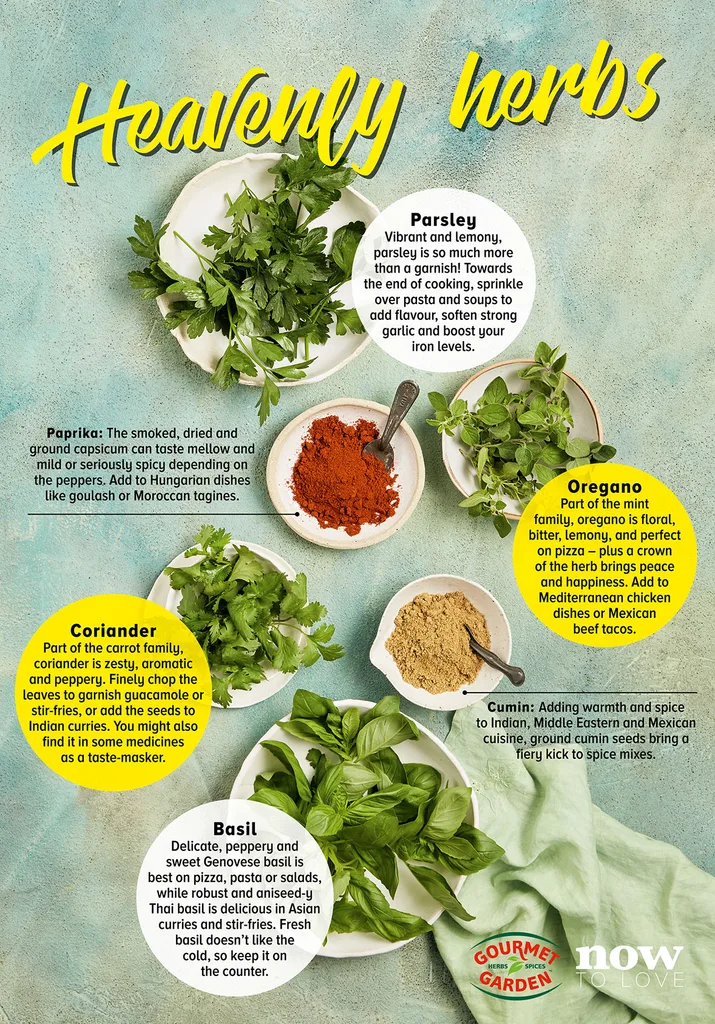Herbs and spices can be a culinary minefield. You want your dish to be bursting with flavour, but a sprinkle of the wrong sort can ruin dinner.
Don’t despair, help is at hand. Here’s the lowdown on when to pop the lid on the most popular jars in the herb rack.

Parsley
Vibrant and lemony, parsley is so much more than a garnish. There are two varieties to experiment with: flat-leaf and curly. The first has a stronger flavour, so is perfect for adding depth to pasta and soups, softening strong garlicky sauces and giving your body an iron boost. Chop up a little curly parsley for a finishing flourish. Be warned: This herb doesn’t appreciate heat so hold off adding until the last minute.
Keep hold of the stems too — added to a muslin bag with dry bay leaf, peppercorns and fresh thyme, they’ll transform in to a bouquet garni for flavourful stocks, stews and soups. If you’re not adverse to a little kick, pair some parsley with coriander, chilli and garlic for a chimichurri sauce, or better yet, save yourself some hassle and pick up Gourmet Garden’s Chimichurri Finishing Drizzle add an authentic South American flavour to any dish.
Coriander
Part of the carrot family — and probably the most polarising herb around — coriander is zesty, aromatic and peppery. It’s also almost entirely edible, from the root to the tip. Fun fact: In the US, the seeds are known as coriander and the leaves, cilantro. Both are incredibly versatile.
Finely chop the leaves in a food processor to garnish guacamole, salsa and stir-fries. Any leftovers can be mixed with olive oil, added to an ice-cube tray and frozen for later use. The seeds will spice up Thai and Indian curries and Mexican dishes like fajitas. You’ll even find coriander in some medicines to mask the taste.
Basil
There are two popular varieties of basil: Genovese (delicate, peppery and sweet) and Thai (robust with aniseed notes and cinnamon scent). The first can be found in Italian cooking. Think Margherita pizza, rich pasta sauce and tomato and mozzarella salad.
Thai basil brings that distinctive Asian taste to curries, noodle dishes and stir-fries. Some believe basil has healing properties: soothing inflammation and warding off stress. Just be sure to keep on the kitchen counter rather than in the fridge: the leaves discolour in the cold. Or make life easier with Gourmet Garden’s Basil Pesto Finishing Drizzle. Pour over grilled chicken and veggies for a fresh twist on a midweek staple. No mess, no fuss — simply shake, tear and drizzle. Too easy!
Oregano
Part of the mint family, oregano is floral, bitter, lemony — and perfect on pizza. Did you know that in ancient Greece, newlyweds were gifted crowns made from the little green leaf to bring peace and happiness?
They probably didn’t realise it’s also a nutritional powerhouse. Just 100g of oregano contains four times the amount of antioxidants found in everyone’s favourite superfood: blueberries. Try adding it to Mediterranean chicken dishes or Mexican beef tacos for a fresh twist on a midweek staple.
Cumin
This distinctive spice has been adding warmth, nuttiness and spice to Indian, Middle Eastern and North African cuisine for centuries. There’s even evidence the Egyptians used cumin as a preservative in the mummification process and the spice gets a name check in the Bible.
In fact, back in the Middle Ages food was seasoned with cumin rather than black pepper because it was cheaper and more readily available. Nowadays ground cumin seeds are used to add a fiery kick to spice mixes, like chilli powder and garam masala and barbecue sauce. The whole seeds can be toasted and added to bread mix, couscous with apricots or roasted veggies.
Paprika
Paprika is instantly recognisable as the red dusting that makes potato salad or prawn cocktail taste so good. Not only is this spice delicious, but it’s also rich in vitamin A which is a powerful antioxidant. Ripe capsicum is the fruit behind the rich spice, sometimes smoked then dried and ground to give it the distinctive colour the Spanish discovered in the 14th century.
It can taste mellow and sweet or seriously spicy, depending on the mix of sweet capsicum varieties and where they originated from. Try adding to Hungarian dishes like winter favourites goulash or Moroccan tagines, but don’t overheat otherwise the flavour will turn bitter.
Brought to you by Gourmet Garden Herbs and Spices











